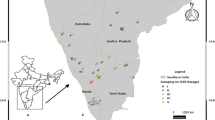Abstract
A species-diagnostic SCAR marker for identification of the stingless bee (Trigona pagdeni Schwarz) was successfully developed. Initially, amplified fragment length polymorphism analysis was carried out across representatives of 12 stingless bee species using 64 primer combinations. A 284 bp band restrictively found in T. pagdeni was cloned and sequenced. A primer pair (CUTP1-F/R) was designed and tested for species-specificity in 15 stingless bees. The expected 163 bp fragment was successfully amplified in all examined individuals of T. pagdeni (129/129). Nevertheless, cross-species amplification was also observed in T. fimbriata (1/3), T. collina (11/112), T. laeviceps (1/12), and T. fuscobalteata (15/15), but not in other species. SSCP analysis of CUTP1 further differentiated T. fuscobalteata and T. collina from T. pagdeni. Although T. laeviceps, T. fimbriata, and T. pagdeni shared an identical SSCP genotype, they are not taxonomically problematic species.





Similar content being viewed by others
References
Amano K, Nemoto T, Heard TA (2000) What are the stingless bees, and why and how to use them as crop pollinators?—a review. JARQ 34:183–190
Crane E (1992) The past and present status of beekeeping with stingless bees. Bee World 73:29–42
Dollin AE, Dollin LJ, Sakagami SF (1997) Australian stingless bees of the genus Trigona (Hymenoptera: Apidae). Invertebr Taxon 11:861–896
Franck P, Cameron E, Good G, Rasplus JY, Oldroyd BP (2004) Nest architecture and genetic differentiation in a species complex of Australian stingless bees. Mol Ecol 13:2317–2331
Heard TA (1999) The role of stingless bees in crop pollination. Ann Rev Entomol 44:183–206
Hoelzel AR, Green A (1992) Analysis of population-level variation by sequencing PCR-amplified DNA. In: Hoelzel AR (ed) Molecular genetic analyses of populations: a practical approach. IRL Press, Oxford, pp 159–187
Klakasikorn A, Wongsiri S, Deowanish S, Duangphakdee O (2005) New record of stingless bees (Meliponini: Trigona) in Thailand. Nat Hist J Chulalongkorn Univ 5:1–7
Liu ZJ, Cordes JE (2004) DNA marker technologies and their applications in aquaculture genetics. Aquaculture 238:1–37
Michener CD (1961) Observations on the nests and behavior of Trigona in Australia and New Guinea (Hymenoptera, Apidae). Am Mus Novit 2026:1–46
Michener CD (1974) The social behavior of the bees, a comparative study. Belknap Press of Harvard University Press, Cambridge, Massachusetts
Michener CD (1990) Classification of the Apidae (Hymenoptera). Univ Kansas Sci Bull 54:75–164
Michener CD (2000) The bees of the world. Johns Hopkins University Press, Baltimore
Michener CD, Boongird S (2004) A new species of Trigona from peninsular Thailand (Hymenoptera: Apidae: Meliponini). J Kans Entomol Soc 77:143–146
Pignata MIB, Diniz-Filho JAF (1996) Phylogenetic autocorrelation and evolutionary constraints in worker body size of some neotropical stingless bees (Hymenoptera, Apidae). Heredity 76:222–228
Sakagami SF (1978) Tetragonula stingless bees of the continental Asia and Sri Lanka. J Fac Sci Hokkaido Univ Ser VI Zool 21:165–247
Sakagami SF, Khoo SG (1987) Taxonomic status of the Malaysian stingless bee Trigona reepeni, with discovery of Trigona padgeni from Northern Malaya. Kontyu 55:207–214
Sakagami SF, Inoue T, Yamane S, Salmah S (1983) Nest architecture and colony composition of the Sumatran stingless bee Trigona laeviceps. Kontyu 51:100–111
Sakagami SF, Inoue T, Salmah S (1985) Key to the stingless bee species found or expected from Sumatra. In: Ohgushi RI (ed) Evolutionary ecology of insects in humid tropics, especially in central Sumatra. Kanazawa University, Japan, Sumatra Nature Study, pp 37–43
Sambrook J, Russell DW (2001) Molecular cloning: a laboratory manual, 3rd edn. Cold Spring Harbor Laboratory Press, New York, USA
Slaa EJ, Sanchez LA, Sandi M, Salazar M (2000) A scientific note on the use of stingless bees for commercial pollination in enclosures. Apidologie 3:141–142
Smith DR, Hagen RH (1996) The biogeography of Apis cerana as revealed by mitochondrial DNA sequence data. J Kans Entomol Soc 69:294–310
Starr CK, Sakagami SF (1987) An extraordinary concentration of stingless bee colonies in the Philippines with notes on nest structure (Hymenoptera: Apidae: Trigona spp.). Insect Soc 34:96–107
Vos P, Hogers R, Bleeker M, Reijans M, van de Lee T, Hornes M, Frijters A, Pot J, Peleman J, Kuiper M, Zabeau M (1995) AFLP: a new technique for DNA fingerprinting. Nucleic Acids Res 23:4407–4414
Waldschmidt AM, De Barros EG, Campos LAO (2000) A molecular marker distinguishes the subspecies Melipona quadrifasciata quadrifasciata and Melipona quadrifasciata anthidioodes (Hymenoptera: Apidae, Meliponinae). Genet Mol Biol 23:609–611
Acknowledgments
We thank Assoc. Prof. Dr. Deborah Smith and Prof. Dr. Charles D. Michener, University of Kansas, for their help in taxonomic identification of specimens and critical suggestions for the early version of the manuscript. We would also like to acknowledge the Center of Excellence for Marine Biotechnology and the Bee Research Unit, Faculty of Science, Chulalongkorn University, for providing facilities required by the experiments. A student grant (S. Thummajitsakul) was supported by the Royal Golden Jubilee PhD program (Grant No. PHD/0075/2546), the Thailand Research Funds (TRF).
Author information
Authors and Affiliations
Corresponding author
Rights and permissions
About this article
Cite this article
Thummajitsakul, S., Klinbunga, S. & Sittipraneed, S. Development of a Species-Diagnostic Marker for Identification of the Stingless Bee Trigona pagdeni in Thailand. Biochem Genet 48, 181–192 (2010). https://doi.org/10.1007/s10528-009-9300-0
Received:
Accepted:
Published:
Issue Date:
DOI: https://doi.org/10.1007/s10528-009-9300-0




